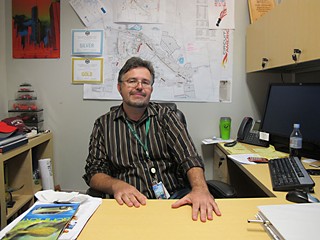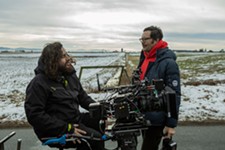Green or Greenwash?
Formula One tests the city's standards for sustainable projects
By Richard Whittaker, Fri., Nov. 16, 2012
The city of Austin may not be directly invested in the Circuit of the Americas, but Austin has definitely staked some of its reputation as a green city on the project. On June 29, 2011, City Council approved a deal confirming its support of the track (see "City Hall Hustle: Skid Marks on the Dais," July 1, 2011), but that came with some major strings attached. Council Member Chris Riley said, "I want the deal to reflect Austin's commitment to sustainability, and ... I want the F1 site to be seen as a model for sustainability efforts." But critics of the project argue that Austin simply signed off on a "greenwashing" memo.
A month after council OK'd the deal, City Manager Marc Ott and the Circuit Events Local Organizing Committee approved its final language. Six of the document's 19 pages, called "Exhibit A," itemize the green requirements for Austin to maintain its relationship with the track.
That's where Edgar Farrera comes in. A 20-year veteran of large-scale environmental projects, he was hired by COTA in January as the first-ever dedicated sustainability officer anywhere on the international Grand Prix circuit (see "Formula Farrera," Jan. 13). His job is to make sure the Circuit complies with the deal, but he says his personal commitment is to exceed its terms. One source close to the project said it's sometimes been difficult to hear Farrera's voice over the maelstrom of construction and deadlines. Yet Farrera himself is upbeat, if realistic, about the challenges he faces.
The deal breaks down into three components: structural, operational, and long-term. The structural elements are built into the track and its surrounding developments, such as energy efficiency requirements for all new buildings bigger than 2,000 square feet. The core of the long-term plan is building a Green Racing and Transportation Research, Education, and Testing Center, as well as encouraging auto races that stress efficiency and alternative energy, such as the student engineering competition Formula SAE.
But the most pressing terms concern operational elements: how the track will minimize its environmental impact on race days. Put simply, 120,000 people at the track generate a lot of waste and a lot of emissions. Farrera seems confident that the systems he has put in place can work – if racegoers understand them and abide by the rules. For example, the track worked with caterers Sodexo and the staffs at Texas Disposal Systems and Ecology Action to maximize recyclables. However, track management can provide all the necessary recycling and composting bins, but it takes only 10% contamination to turn it into 100% trash. So across race weekend, Farrera will have volunteers directing visitors to throw the right trash in the right bins. "Because the majority of our impact is going to be large events," he said, "a lot of the opportunities will deal with the large number of people coming out here and our ability to influence them, hopefully positively."
If the Circuit can green up race weekends, it could help other big events like Austin City Limits and South by Southwest.
Farrera also sees an opportunity for COTA to innovate on the national stage – in no small part because so little has yet been done. In September, he attended the second annual Green Sports Alliance summit in Seattle. He said, "I met the head of sustainability for the National Hockey League; they've had that position for two months. Major League Baseball, that position's been around for maybe nine months." For Farrera, sustainable event planning is where sustainable architecture was a decade ago: "There was an understanding that we needed to do better, that we could do better, but that we also needed better tools. We had the questions, but we didn't have the answers."
Little and Late?
Nevertheless, not everyone involved in the city's green agreement is happy with it. Tom "Smitty" Smith of Public Citizen, who was part of the advisory group that helped draft Exhibit A, said, "The process was set up to fail from day one." He found that the track limited negotiations and pressured the city by threatening to pull the deal. He said, "Our hands were tied behind our back and most of our fingers were tied together." The result, he says, is "a lightly greenwashed program." He argues that if the city had more time, there could have been better transport and infrastructure planning, as well as better terms governing vendors. Instead, he said, "We're stuck with a deal that probably should never have been done."
Smitty doesn't blame Farrera, whom he called "a well-meaning man with a lot of skills and talent." But he says Farrera should have been at the table from the beginning, not brought in when the track was already under construction. Instead, he points the finger squarely at project attorney Richard Suttle, saying, "It's another of those 'Hurry up and make the deal or we'll take it elsewhere' flimflams that the city of Austin management falls for repeatedly."
Indeed, Farrera acknowledged that having a deal signed before there was a sustainability officer created some problems for him. Early on, he had to review the deal in depth, analyzing "not just how I understood it, but how the city viewed it." Coming on board after construction started limited some of his input: "You could say that perhaps I would have loved to come in earlier in the design and have a hand in that." Similarly, some of the terms of the deal were good ideas with hidden issues.
Take the COTA commitment to buy 50% of its carbon offset credits locally. Farrera said, "It sounded very simple, but as I started looking into it, I discovered there weren't any true third-party-certified carbon-offset programs in the city limits." But rather than give up, he started working on a sequestration program with the city and local urban forestry nonprofit TreeFolks. Similarly, he pushed hard for the Eco Opt-In Ticketing Initiative: Starting with the track's first MotoGP race, scheduled for April 2013, racegoers will be able to add a donation to one of three local environmental groups. It sounds simple, but Farrera said it came with many technical and process challenges.
Like Smith, environmental activist Scott Johnson is still unhappy with the deal. An emissions expert, he worked with Smith on some terms of the green deal, such as a requirement to minimize ozone-forming and carbon emissions from construction and landscaping for all future projects. He says a lot of work remains to be done. He's most concerned that some steps the track is taking, like buying carbon credits, will have no real impact on the local pollution effects of race day. He said, "Reducing carbon emissions and offsetting them is not the same as reducing ozone-forming precursor emissions and particulate matter" – especially, he noted, if the carbon credits are being bought outside of Central Texas.
Gathering the Data
On race day itself, the biggest single source of pollution will be combustion engines – not of the race cars, but of the buses and cars taking people to and from the Circuit. The longer that process takes, the worse the pollution will be. COTA held its first big event on Nov. 3 with Formula Run, a 5K footrace on the track. Bad weather didn't help, but just 5,000 runners caused traffic jams on a Saturday morning. Still, the city and the track are gambling that a huge public transport initiative will ease the problems (see "Planes Trains Automobiles"). Council Member Riley – a keen bicyclist himself – was most excited about the cycle track from Richard Moya Park to a shuttle valet service near the Circuit and has given feedback to city staff about sections that still need help. "If I have to be out there with a broom myself," he said, "I will be making sure that we've got that path clear."
Smitty sees the bike park as a Pyrrhic victory, because the bicycle route itself stops short of the Circuit. He said, "You can ride to the park, but you still have to take the bus to get out there, which [eliminates] most of the value of having bicycles." He sees that as part of a slate of "promises that were made that were barely kept, and many [that] were hollow in the first place."
Neither Riley nor Farrera is expecting a "zero emissions" race in the first year, but both are expecting a lot of data. Farrera has continually updated Smith and the council – via the city's Chief Sustainability Officer Lucia Athens – on his progress and plans to present an F1 "green score card" in January. He has assembled a team of 50 volunteers to monitor air quality, while the track will be recording energy usage across the day. "We've got a plan on paper," said Farrera, "and I hope we get some of the results we're hoping for." Once the race is over, he and his staff will spend the next month collating all the data they've collected.
That data is where the rubber will truly meet the road – and determine whether the deal was a true step toward environmental responsibility, or whether Smitty and other critics are right. Riley said, "The jury's still out on overall performance, but what's clear is that we have mechanisms in place to gauge this first year and to ensure that we do better in future years."
Got something to say on the subject? Send a letter to the editor.













